Pesticide Usage in Scotland: Rodenticides on Grassland and Fodder Farms 2021
This report presents the results of a survey of rodenticide use on grassland and fodder farms in Scotland in 2021.
This document is part of a collection
Rodenticide use data
Rodenticide use data were collected from 601 grassland and fodder holdings (423 and 178 respectively) in Scotland in 2021. The growers surveyed represented seven per cent of the holdings growing fodder crops and one per cent of those with grassland. These holdings collectively grew three per cent of the total 2021 Scottish fodder and grass crop area. Rodenticide use data from these sampled farms were used to estimate rodenticide use on all Scottish grassland and fodder farms in 2021.
Percentage of farms using rodenticides and type of user
It was estimated that on almost three quarters of Scottish grass and fodder farms (73 per cent) no rodenticides were used in 2021 (Figure 1). On those farms where rodenticides were applied (27 per cent of farms) over half of all baiting operations (56 per cent) were implemented by farmers. Pest Control Professionals (PCPs) conducted baiting on the remainder of these farms. Similar proportions were recorded in relation to the quantity of rodenticide used with farmers responsible for 58 per cent of the total use by weight of product.
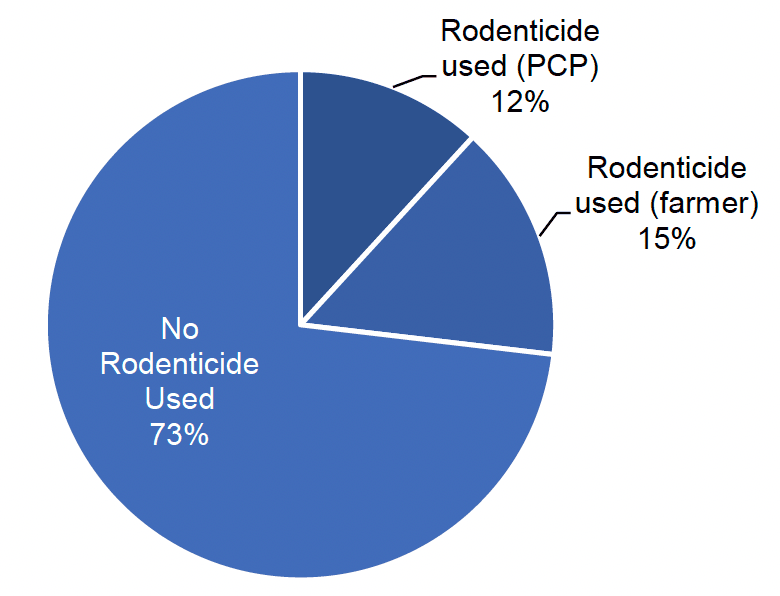
The estimated percentage of farms using rodenticides, and associated user type, in the previous two surveys (2013 and 2017) is presented in Figure 2. The proportion of grassland and fodder farms using rodenticides in 2021 (27 per cent) was lower to that in 2017 (35 per cent, p-value ≤ 0.01) and in 2013 (43 per cent). There was very strong evidence that the proportion of farms using rodenticides has declined over the last three surveys (p-value ≤ 0.001).
In 2021, on farms where rodenticides were used, there was very strong evidence the proportion applied by PCPs (44 per cent) increased from the 2017 survey (27 per cent, p-value ≤ 0.001), and from the 2013 survey (22 per cent, p-value ≤ 0.001). Recent surveys, since the introduction of the rodenticide stewardship scheme, have shown a trend of an increasing proportion of farms using PCPs to apply rodenticides (with the exception of the 2020 Rodenticide Use on Arable Farms survey(3) which reported a slight decline in the use of PCPs possibly influenced by the impact of COVID-19 related restrictions).
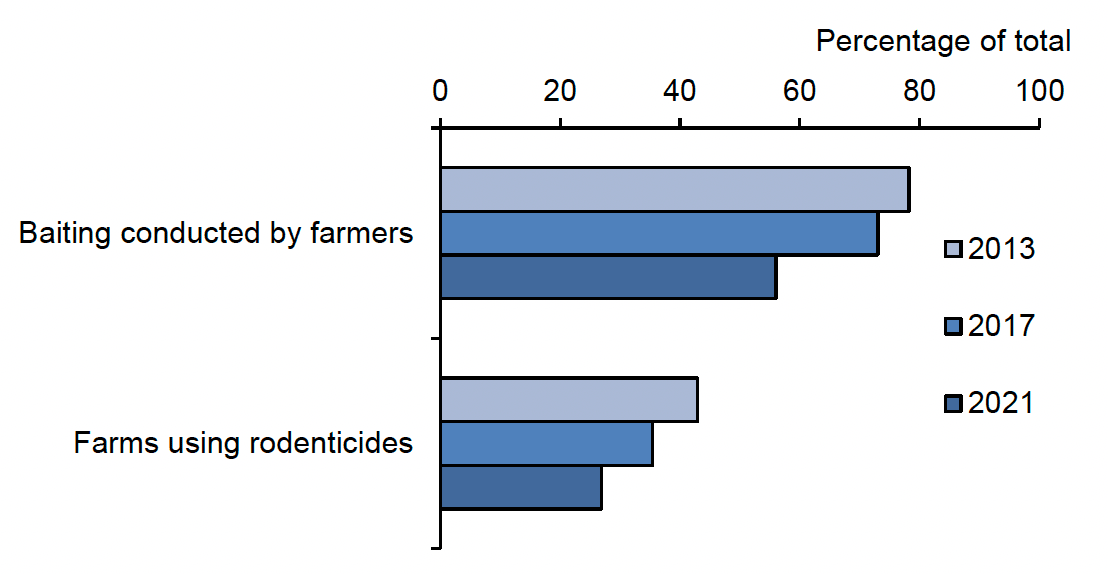
Note: There was very strong evidence that the proportion of farms using rodenticides declined over the three surveys (p-value ≤ 0.001). There was also very strong evidence that the proportion of baiting conducted by farmers decreased between 2017 and 2021 and across the three surveys (p-value ≤ 0.001).
Rodenticides encountered and their estimated occurrence
During this survey, product information was recorded for 90 per cent of all occurrences of rodenticide use. For the remaining 10 per cent, whilst it was recorded that rodenticides had been applied, the product used was not specified. This was either a result of farmers not having adequate records of the exact product used or PCPs not responding to requests for product details. The level of unspecified rodenticides in 2021 was similar to that encountered in 2017 (11 per cent) and 2013 (eight per cent). The following sections only discuss the use of specified rodenticides.
Rodenticide occurrence is the number of holdings on which a formulation (the combination of active substances formulated together in a product) is encountered. Multiple uses of the same formulation at the same holding are counted as a single occurrence (refer to Appendix 3 for further explanation of these definitions).
Nine active substances were recorded on grass and fodder farms in 2021: alphachloralose, brodifacoum, bromadiolone, cholecalciferol, coumatetralyl, difenacoum, difethialone, flocoumafen and warfarin (Table 1, Figure 3). The majority of the rodenticides encountered were anticoagulants, which prevent the synthesis of blood clotting factors and cause rodent death by haemorrhage. The active substances encountered represent all anticoagulant rodenticides currently approved in the UK.
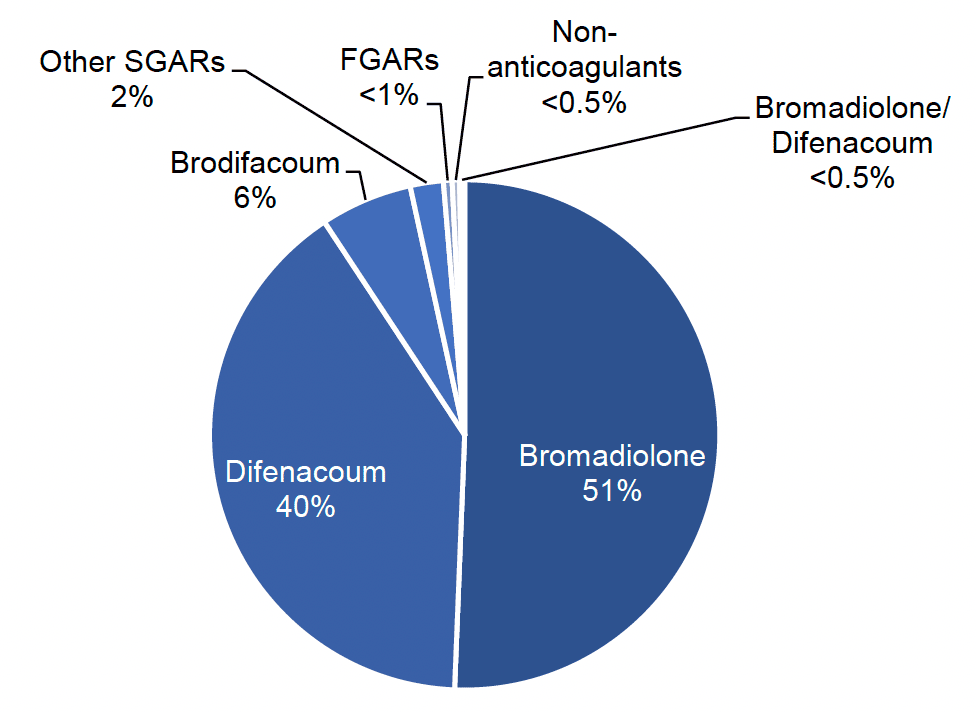
Note: Other SGARs are difethialone and flocoumafen. FGARs are coumatetralyl and warfarin. Non-anticoagulants are alphachloralose and cholecalciferol
Five of these compounds are second generation anticoagulant rodenticides (SGARs; brodifacoum, bromadiolone, difenacoum, difethialone and flocoumafen), two are first generation anticoagulant rodenticides (FGARs; coumatetralyl and warfarin) and two are non-anticoagulant compounds (alphachloralose and cholecalciferol). Cholecalciferol was previously authorised for use in the UK but was then withdrawn. It was re-authorised from October 2020, therefore this is the first pesticide usage survey to record its use since 2010 (on arable farms). Cholecalciferol causes rodent death by inducing abnormally high levels of calcium in the blood (hypercalcaemia). Over the last three surveys rodenticide use has been almost exclusively SGARs (99, >99 and 99 percent in 2013, 2017 and 2021 respectively).
The most commonly encountered formulations were bromadiolone and difenacoum (51 and 40 per cent of all occurrences respectively). Other formulations included brodifacoum (six per cent of occurrences), difethialone (two per cent), alphachloralose, bromadiolone/difenacoum, cholecalciferol, coumatetralyl, flocoumafen and warfarin (all less than one per cent).
The dominance of bromadiolone and difenacoum occurrence reflects these being the most commonly available rodenticides. At the time of writing, bromadiolone and difenacoum containing products account for 57 per cent of all anticoagulant rodenticide approvals, 59 per cent of those approved for outdoor use around buildings and 99 per cent of those approved for use in open areas(4).
The combined use of bromadiolone, brodifacoum and difenacoum has changed little over time, accounting for 97, 98 and 99 per cent of total occurrences in 2021, 2017 and 2013 respectively. However, the relative proportions of these compounds have changed since the last survey. In 2021, the number of farms using bromadiolone was higher (p-value ≤ 0.001) than in 2017. In contrast, fewer famers used difenacoum in 2021 (p-value ≤ 0.001) than in 2017. Difenacoum was the most commonly used rodenticide in the previous two surveys. The number of farms using brodifacoum, the third most commonly encountered rodenticide in this survey, was similar to previous surveys (six, four and eight per cent in 2021, 2017 and 2013 respectively). There was no evidence that the proportion of farms using brodifacoum differed between 2017 and 2021 though there was some evidence that the three years differed, perhaps corresponding to higher levels in 2013 (p-value ≤ 0.05). The relative proportions of these compounds vary in the longer-term dataset (particularly in the more frequently collected rodenticide use on arable farm data series - 1992 onwards) and it is not clear what the drivers for these variations are. It is possible that this may be a response to product efficacy in some areas; resistance to both difenacoum and bromadiolone has been reported in Scotland(5). PCP experience of suspected resistance to rodenticides on farms is discussed in the compliance with rodenticide best practice section. It may also represent a response to differences in the range of approved products available and their marketing strategies over time. Two non-anticoagulant rodenticides were reported to have been used in the 2021 survey, alphachloralose and cholecalciferol, both accounting for less than one per cent of total rodenticide occurrences. In contrast no non-anticoagulant rodenticides were reported to have been used in the previous survey in 2017. In 2013 a small amount of aluminium phosphide was reported to have been used for rodent control (one per cent of total rodenticide occurrences).
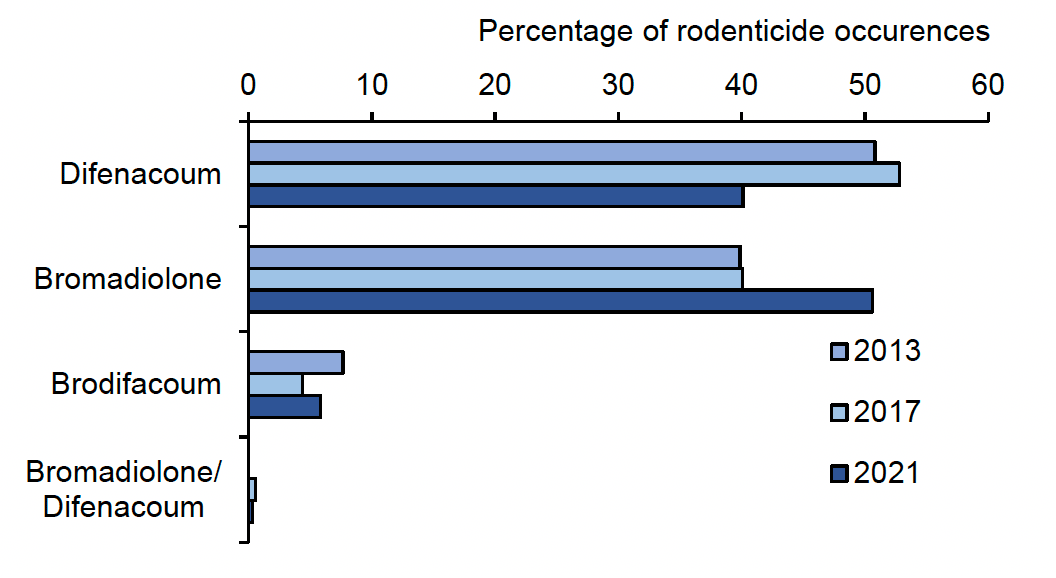
Weight of rodenticides used
Approximately 85 tonnes of rodenticidal products are estimated to have been used on Scottish grassland and fodder farms in 2021 (Table 2, Figure 5).
In line with the occurrence data, more than 99 per cent of the total weight used was of SGAR products. Products containing bromadiolone were the most commonly used (ca. 52 tonnes), accounting for 61 per cent of total rodenticide use by weight. Difenacoum products were the second most commonly used (ca. 28 tonnes) accounting for 33 per cent of total use. Brodifacoum was the only other rodenticide regularly encountered (ca. 3 tonnes), accounting for four per cent of total use. Individual formulation weights, the weight of active substances present in the product not including baits, are also presented in Table 2. Anticoagulant rodenticide products contain very small amounts of active substance. The ca. 85 tonnes of rodenticide product used on grass and fodder farms in 2021 contained only ca. 6.4 kg of active substance, the remainder of the product weight is almost exclusively food bait used to attract rodents. This is very similar to the estimated weight of active substance reported in 2017 (ca. 6.5 kg) despite a 34 per cent decrease in weight of rodenticide product. This may have been influenced by the presence of the active substance alphachloralose which was recorded in 2021 but not in 2017. Alphachloralose products contain much higher levels of active substance (four per cent w/w) compared with anticoagulants (ca. 0.005 w/w). Therefore, although alphachloralose accounted for less than one per cent of the total product use in 2021 (by weight), it accounts for 33 per cent of total active substance use.
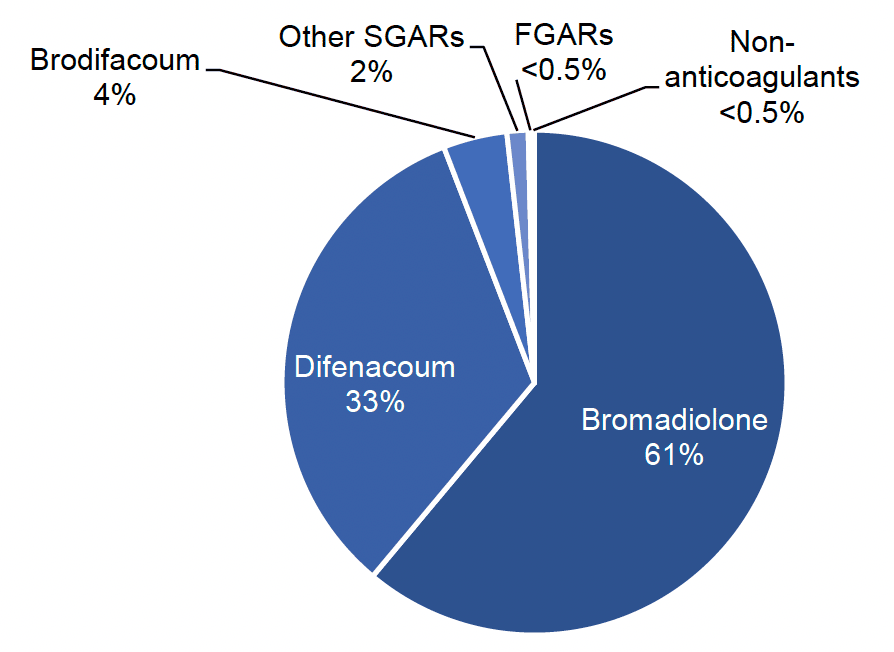
Note: Other SGARs are bromadiolone/difenacoum, difethialone and flocoumafen. FGARs are coumatetralyl and warfarin. Non-anticoagulants are alphachloralose and cholecalciferol
The estimated weights of the three main rodenticides recorded in the 2013, 2017 and 2021 grassland and fodder crop surveys are presented in Figure 6. There has been a large decrease in overall weight of rodenticide products applied between these three surveys. Rodenticidal product use in 2021 (ca. 85 tonnes, was 34 per cent lower than in 2017 (ca. 130 tonnes) and 61 per cent lower than in 2013 (ca. 217 tonnes). This overall reduction is being driven by a decline in SGARs, which decreased by 32 per cent since 2017 and 61 per cent since 2013. In contrast the use of FGARs and non-anticoagulants have increased although these both make up less than one per cent of the total weight of rodenticide products used. The decline in overall rodenticide use on grassland and fodder farms is similar to that recorded in recent arable farm surveys (with the exception of the 2020 Rodenticide use on arable farms which recorded a 27 per cent increase in weight compared with 2018, possibly impacted by the COVID-19 pandemic). Estimated rodenticide use on arable farms in 2020 was 32 per cent lower than in 2016 (ca. 91 tonnes) and 57 per cent lower than that reported in 2000 (ca. 144 tonnes)(6). This has partly been driven by a decline in the proportion of farms on which baiting is conducted and may also have been influenced by the greater use of PCPs.
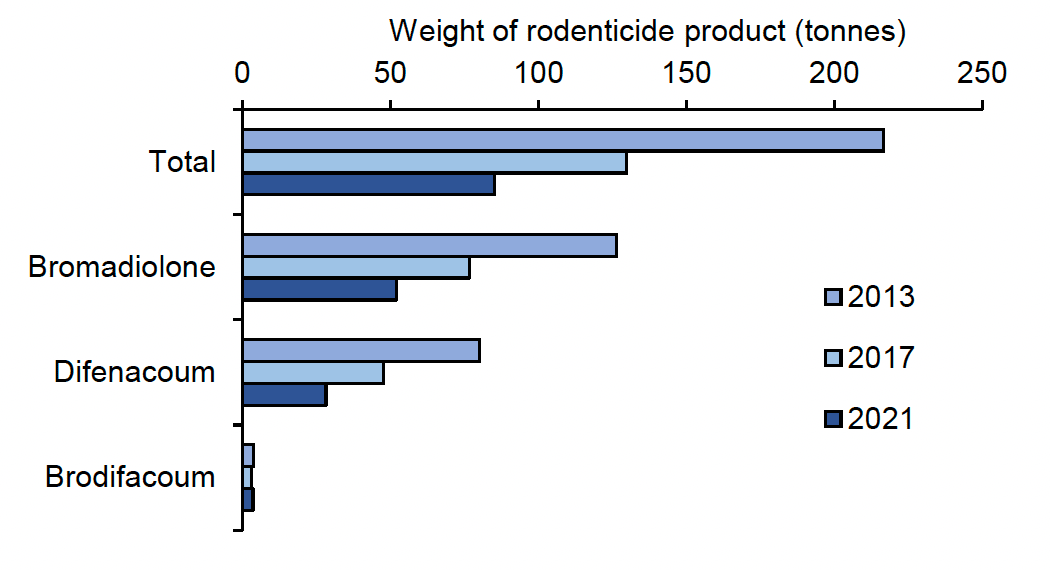
Note: Bromadiolone/difenacoum products have been included in total
PCPs applied 42 per cent of the total weight of rodenticide used in 2021. The weight applied by PCPs declined by 45 per cent despite an increase in the use of PCPs (responsible for 44 per cent of farms in 2021 where rodenticides were used, compared to 27 per cent in 2017). In contrast the weight of pesticide applied by farmers in 2021 only reduced by 24 per cent compared to the previous survey. Farmers were responsible for 56 per cent of the farms where rodenticides were used in 2021 compared to 73 per cent in 2017. Therefore, the decrease in estimated rodenticide use in this survey stems largely from a decrease in use by PCPs.
At active substance level, there were declines in weight recorded for both difenacoum and bromadiolone use (41 and 32 per cent decrease respectively) in 2021 compared with 2017. In contrast, applications of products containing brodifacoum increased by 16 per cent in 2021 compared with 2017 but were similar (five per cent lower) to use in 2013 (Figure 6). The reasons for these changes are unclear, and it should be noted that rodent populations, and thus rodenticide use, fluctuate over time. The decline in rodenticide use and increased use of PCPs, which have been detected in both arable (pre 2020) and grass and fodder crop systems, are likely to have been influenced by the Campaign for Responsible Rodenticide Usage (CRRU) guidance for best practice(7) and the 2015 launch of the UK industry led rodenticide stewardship scheme(8). The CRRU Code of Best Practice was revised and published in 2021 following a number of changes regarding regulation and permitted practical uses of professional rodenticides (see rodenticide approval and stewardship section for further details).
Seasonal use of rodenticides
The season in which rodenticides were used was specified for over 99 per cent of all rodenticides encountered. Sixty-nine per cent of use was reported to occur throughout the year. This included farms practising permanent baiting and those conducting multiple separate baiting operations. This is an increase from the level of year-round baiting encountered in the 2017 survey in which 54 per cent of rodenticides were reported to be used in year round baiting regimes. However, it is slightly lower than the 75 per cent reported in 2013. Year-round baiting was also lower in the Rodenticide Use on Arable Farms 2020 report where 45 per cent of rodenticides were reported to have been applied throughout the year. It is possible the increased use of PCPs in 2021 may have resulted in increased year-round use of rodenticides as PCPs are often contracted to visit farms on a monthly basis.
When the weight used, including year-round use, is separated into constituent seasons, the greatest use was in winter (34 per cent) and autumn (27 per cent), with lower use during spring and summer (Figure 7). This is a very similar seasonal pattern to that encountered in previous surveys of rodenticide use in both grassland and arable systems.
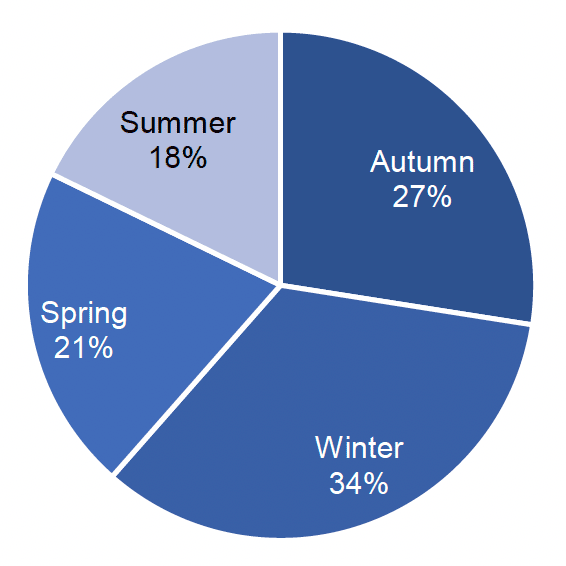
Rodenticide bait type and target
As in previous surveys, baits formulated with grain were the most commonly encountered in this survey, accounting for 89 per cent of use by weight, compared with 88 per cent in 2017 and 80 per cent in 2013 (Figure 8). These baits were primarily loose grain and place packs containing grain, but also included a small amount of pelletized/block grain (nine per cent of total grain baits) and grain based paste (one per cent).
The other types of rodenticide products encountered in 2021 included wax based baits, which accounted for 10 per cent of use. Eighty five percent of wax baits were solid wax blocks and 15 per cent were soft wax. Pasta based bait contributed one per cent of total use and other paste rodenticides (for which the type of bait wasn't specified) accounted for less than one per cent.
The use of grain baits has slightly increased during the last three surveys from 80 per cent of all rodenticide bait in 2013 to 88 per cent in 2017 and 89 per cent in 2021 (Figure 8). The type of grain bait also appears to be changing slightly. Use of loose grain and place packs containing grain has declined slightly from 99 per cent of all grain bait in 2017 to 90 per cent in 2021. In contrast, the use of pelletized or block grain has increased from one per cent in 2017 to nine per cent in 2021. Use of grain paste continues to be low.
The use of wax-based bait has also increased from four per cent of all rodenticide bait in 2013 but then has remained at 10 per cent in both 2017 and 2021. Although use was similar between the last two surveys, the wax types have changed. Use of soft wax has increased (four per cent of all wax bait in 2017 to 15 per cent in 2021) with wax block use decreasing. The use of pasta bait has declined in recent years, from 15 per cent of all rodenticide bait in 2013 to only two per cent in 2017 and one per cent in 2021. Use of other bait types such as gel, concentrates or other unspecified pastes have consistently contributed to less than one per cent of total weight applied in recent surveys.
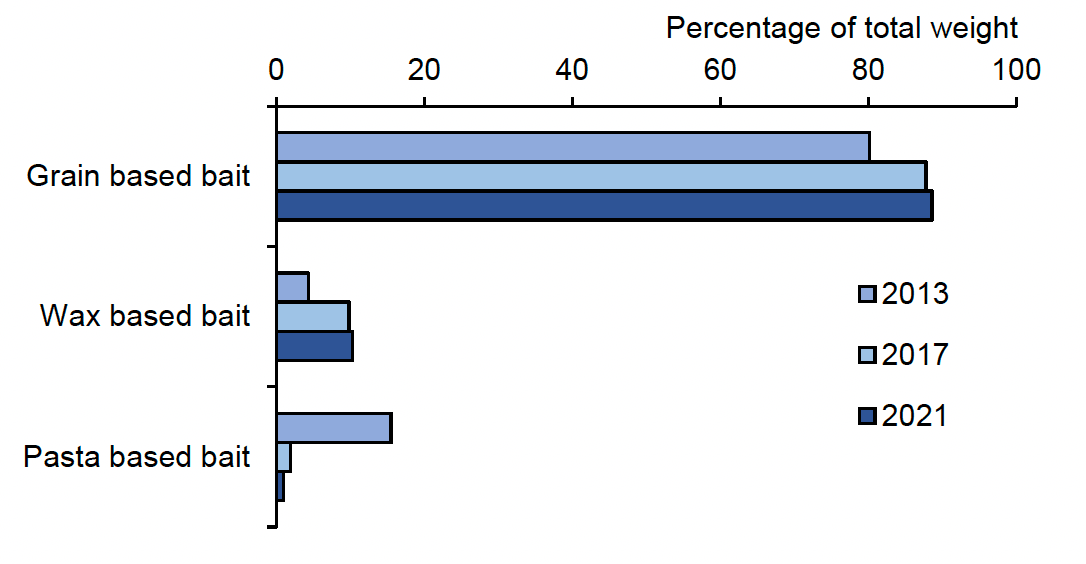
Note other bait such as gel/concentrate/unspecified paste has been excluded as it represents < one per cent of total weight applied
Survey respondents were asked to state the target of their rodenticide baiting regimes (Figure 9) and this information was supplied for over 99 per cent of estimated use by weight. Where reason data were supplied the most common target was a combination of rats and mice (69 per cent), followed by rats 29 per cent. Only two per cent of rodenticide use was targeted at mice alone. In the previous survey in 2017 the principal target was rats (57 per cent) followed by a combination of rats and mice (37 per cent). Rodenticide target data were not collected in the 2013 grass and fodder farm survey.
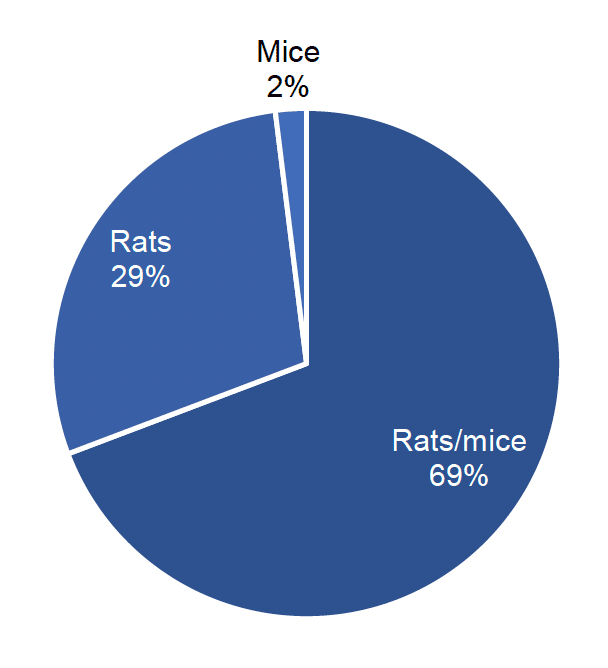
Contact
Email: psu@sasa.gov.scot
There is a problem
Thanks for your feedback